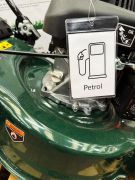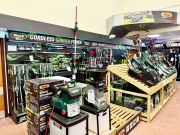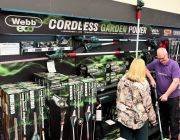8 steps to boost garden machinery sales

For many garden centres, machinery can feel like one of the trickier departments to manage. Products are bulky and can be perceived as technical. But when presented well, machinery not only drives healthy revenue per transaction, it also strengthens your position as a “one-stop” gardening destination.
So how can retailers make this category easier to shop and more rewarding to run? Here are eight practical ideas that can make a big difference:
1. Build a Range with Clear Steps
Shoppers want to feel they’re making the right choice, so offer a ladder of options to cover different budgets and garden sizes. Even a compact selection that shows a clear entry point, mid-point and premium choice gives customers confidence they’re buying the product that suits their needs.
2. Simplify by Focusing on Cordless
Cordless equipment has overtaken petrol in many centres because it’s easier to stock and simpler for customers to use. For retailers who feel nervous about servicing and warranty issues for petrol machinery, a cordless-first offer can provide a full category without the complications.
3. Choose a Display Style That Works for You
There are two main approaches: arranging by product type (all mowers together, all trimmers together, etc), or creating a brand zone with its own signage and display kit. Both can work — the key is to make the area easy to navigate so customers don’t feel overwhelmed.
4. Use Clear, Straightforward Information
For customers, selecting the right garden machinery can be challenging, so make the essentials obvious. Tags that highlight key information are really helpful. In the case of lawnmowers, for example, the tag should include power source, cut width, run time, weight, or whether a mower is self-propelled. Using icons or quick-read bullet points helps people compare models at a glance.
5. Give Staff Confidence, Not Complexity
You don’t need in-house engineers — just colleagues who know what to ask. Questions such as “What size lawn do you have?” or “Would you prefer something lightweight?” are enough to steer most customers in the right direction. Short supplier training sessions can go a long way here.
6. Keep it Clean!
Customers notice when machinery is dusty or surrounded by empty cartons. A tidy, cared-for display suggests quality and builds trust. Regularly wiping down of models and making sure signage is straight and current is a simple win.
7. Link Products to Seasonal Jobs
People rarely shop machinery in isolation — they have a task in mind. Highlight this by grouping relevant items together: a spring lawn-care bay with feed, scarifiers and mowers, or an autumn leaf-clearance theme with blowers, shredders and bags. These “task-based” displays create inspiration and naturally lead to higher basket spend.
8. Make the Most of Supplier Support
Suppliers aren’t just there to deliver stock. Many will provide display systems, in-store materials, and training — and some will even help map out a promotional calendar. Leaning on that support takes pressure off your team and ensures the category keeps performing.
In Summary
Machinery doesn’t need to dominate your floorplan or drain staff resource. With a structured range, simple signage, tidy displays and a bit of supplier backup, you can turn this category into a reliable sales driver and a valued part of your customer experience.
Since the company's creation in 1938, Handy has grown to become one of the UK’s largest independent garden machinery wholesale distributors, supplying specialist dealers, large national retailers, garden centres and mail order companies.
www.handys.co.uk.
Advice written by Mark Moseley, Sales & Marketing Director, Handy




